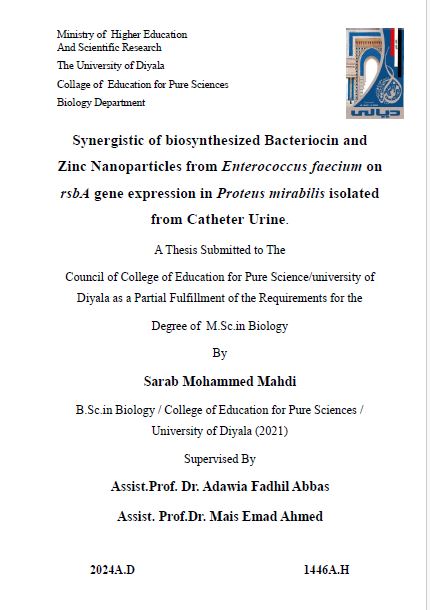المستخلص
There were(200) samples were collected between September and December 2023 ,where (150) from urinary catheter samples were collected from Yarmouk Teaching Hospitals In Baghdad , and (50) Swab collected from gums of healthy people.
Urinary catheter samples was directly cultured on to MacConkey agar and blood agar plates. The number of isolates that gave growth was 110 (73.3%) samples, while the number of samples that non growth was 40 (26%) samples.
samples from gums of healthy people were then cultured in MRS broth. Then on MRS agar 40(80%) sample showed positive growth while non growth in 10(20%) samples .
The diagnostic results using the Gram negative card (GN-Card)and (GP-Card) of the Vitek 2 Compact system showed that 35(31.8%) isolates were P. mirabilis.,and 9(22.5%) isolates were E.faecium .
The sensitivity of the bacterial isolates under study to antibiotics was tested using the Vitek 2 device. Antibiotics were selected from different groups, which are the most common in the treatment of urinary tract infections, including levofloxacin , Imipenem, Cefoxitin, Ampicillin, and Piperacillin. The results showed a clear variation in the sensitivity of the isolates under study to the antibiotics used. All P.mirabilies of bacterial isolates, which numbered 30, showed resistance to (100%) of the antibiotics Cefoxitin and Ampicillin, While their resistance to other antibiotics was variable .
All P. mirabilis isolates were cultured on blood agar to investigate their ability to swarm. The results showed out of (35) isolates, (10) isolates showed swarming motility after 24-48 hrs. incubation at temperature 37 °C
In primary Screening of E. faecium producing to Bacteriocin-like inhibitory by using agar well diffusion (AWD) and filter paper disc (FPD) methods. The results of both methods showed that only four Isolates of E. faecium (E.5, E.20, E.3 and E.11) gave antibacterial activity against E. faecium and the isolate E.20 was the best one, this depending on the results of the FPD method,a also this method was best than the AWD method .
To enhance the growth (1%) glucose and yeast extract was added to the media and was the best carbon and nitrogen source respectively, with a pH of 5 at a temperature 37°C for 72 hours. Notably, the Inhibition zones observed ranged between (15 – 24 )mm.
Zinc oxide nanoparticles were synthesized by a biological method from bacteriocin-like inhibitory substance (BLIS) of E. faecium bacteria isolated from the healthy people’s gums . Where the results showed that white precipitate represent the first visual observation of the Zinc oxide nanoparticles
The ZnO-NPs were characterized using many tests. UV-VIS spectrum reveald the absorption peak of biosynthesized ZnO-NPs at 267 nm. Atomic Force Microscope (AFM) showed the average size of the biosynthesized ZnO-NPs which was about 69.83 nm . The XRD spectra confirmed the formation of ZnO-NPs by revealing three prominent peaks .Energy Dispersive X-ray (EDX) analysis, Show presence of zinc in the ZnO-NPs.FESEM images showed that the particles were of different shapes cohesive in images at 500 x and 2000 x magnification power.
Test activity of ZnO-NP synthesis against against E.feacium (20,5,3) isolated from dental caries obtained ready and identificated from the( Biology Department at College of Science /University of Baghdad ) and P. mirabilis (1,7,26)with varying concentrations of ZnO-NPs (1000, 500, 250, 125, and 62.5 μg/mL)The results showed concentration higher effective on E. faecium bacteria he 1000 μg/mL While the concentration (250, 125 ,62.5)μg/mL it had no effect on the isolates (3,5). As for P. mirabilis bacteria, all concentrations had an effect on the three isolates, except for concentration 62.5μg/mL, It has been shown ZnO-NPs that it has a greater effect on P. mirabilis isolates
The cytotoxicity assay results showed slight decrease in vitality of human lymphocytes treated with biologically synthesized ZnO nanoparticles. These findings Possibility that these methods could be used as a viable alternative to other physical methods currently associated with environmental toxicity.
Detection rsbA gene by PCR for ten isolates from P. mirabilis and according to sequence (M1-M10) all ten isolates contain the gene , these isolates were chosen due capacity swarming phenomenon and to their Multi-Drug Resistance(MDR) status.
The sub-minimum inhibitory concentration (sub-MIC) of ZnO-NPs was 125 µg/ml , determined using microdilution method was used to against P. mirabilis Real-time PCR was used to determine changes in rsbA gene expression to two isolations after exposure to ZnO-NPs at sub-minimum inhibitory concentration (125 µg/ml). The expression of the rsbA gene was significantly downregulated In the one isolate, while the expression of the rsbA gene was upregulated in the other isolate. The reason for the change in results is the power of isolation over swarming phenomenon events




